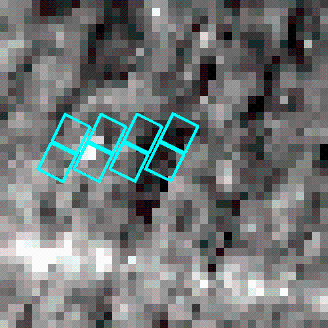Principal: Almudena Alonso
Deputy: Susan Stolovy
Data Monkey(s): Almudena Alonso, Casey Papovich, Susan Stolovy
Priority:
Downlink Priority: Normal
Analysis Time: 24-48 hours
Last Updated:
Objective
To obtain a 24micron Routine Photometry Flatfield in the large field option.
Description
We will obtain IOC acceptable routine 24um PHOTOMETRY
mode large field flatfields (this task is repeated a number of times in different IOC
campaigns) to be used on a regular basis.
Since this task is repeated a number of times during IOC, we will observe
different regions of the sky each time. The task will check for possible variations
of quality of flatfield or saturation. This task will also be useful for
screening regions of the sky to obtain flatfields in SIRTF routine operations.
This task is executed in:
MIPS Campaign V
MIPS Campaign M001
Data Collected
A 4 point dither map (1 cycle) will be obtained at 24microns with 3 second
DCEs in a region of the sky chosen to avoid bright point sources.
The map will require about 16.7 minutes of observing
time. This is the AOR file overlaid on the sky:

HEADER: FILE_VERSION=7.0, STATUS = PROPOSAL
AOT_TYPE: MIPS Photometry
AOR_LABEL: MIPSP-943-Nov27-Jan07
AOR_STATUS: new
MOVING_TARGET: NO
TARGET_TYPE: FIXED CLUSTER - OFFSETS
TARGET_NAME: zodi_0a
COORD_SYSTEM: Equatorial J2000
POSITION1: RA_LON=0h19m54.66s, DEC_LAT=-4d33m52.3s
OFFSET_P2: EAST_ROW_PERP=400.0", NORTH_COL_PARA=0.0"
OFFSET_P3: EAST_ROW_PERP=800.0", NORTH_COL_PARA=0.0"
OFFSET_P4: EAST_ROW_PERP=1200.0", NORTH_COL_PARA=0.0"
OFFSETS_IN_ARRAY: NO
OBSERVE_OFFSETS_ONLY: NO
OBJECT_AVOIDANCE: EARTH = YES, OTHERS = YES
MICRON_24: FIELD_SIZE = LARGE, EXPOSURE_TIME = 3, SKY_OFFSET = 350.0, N_CYCL
ES = 1
SPECIAL: IMPACT = none, LATE_EPHEMERIS = NO,SECOND_LOOK = NO
RESOURCE_EST: TOTAL_DURATION=1008.9585, SLEW_TIME=115.4, SETTLE_TIME=144.3585, S
LEW_OVERHEAD=180.0, SPECIAL_OVERHEAD=0.0, UPLINK_VOLUME=2007, DOWNLINK_VOLUME=81
20880, VERSION=S8.9.0
INTEGRATION_TIME: MIPS_24=35.651585,MIPS_70=0.0,MIPS_160=0.0
Array Data Desired:
All Arrays
Data Reformatting Option:
- NORMAL
1 FITS file per AOR per array.
Special Instructions:
Task Dependencies
- MIPS-100: 24 um first light
- etc.
Calibration Dependencies
Output and Deliverable Products
24 micron mosaic of the observed region. This may be useful for IRS to select
their flatfield regions.
24micron flatfield obtained in PHOTOMETRY large field mode.
A star observed at a grid of positions across the array will be flatfield
to check the quality of the flatfield. We will provide an array map showing
the location dependences -if any- of the photometric sensitivity.
Data Analysis
- Standard Pipeline reduction using the DAT and/or SSC Pipeline. If using
the DAT, we will run MIPS_SLOPER to do the dark subtraction, among other things.
- Produce a mosaic of the observed region using MIPS_ENHANCER to check
for bright sources.
- Median combine 56 images (with some rejection algorithm, e.g., 3sigma
rejection) using the IRAF "imcombine" task to create a flatfield. Alternatively,
once the flatfield DCEs are screened for possible saturation, etc, we can
use the MIPS_ENHANCER to create the flatfield frame using an appropriate
rejection algorithm.
- Flatfield star observations at different positions across the array.
We can use observations of the Focal Plane Survey: MIPS-130 and MIPS-131.
- Aperture photometry on star using the IRAF "phot" task to measure
flux. We will use the tasks: photpars, fitskypars to set up the photometry
parameters (aperture, sky/background estimate).
- Comparison of star aperture photometry at different positions across
the array to determine flatfield accuracy.
- Once the task is executed more than once:
- we can look for possible flatfield variations with time/region of sky
used
- we can determine the number of DCEs necessary to construct a 'super'
flatfield (see A. Alonso's report on flatfield/IC simlations; NEED TO ADD
LINK TO FLATFIELD MODEL WEBPAGE). NOTE: According to our flatfield
simulations we will need approximately > 60DCEs at 24 microns (depending
on the zodi brightness) to get a flatfield with an accuracy of 0.2% (rms,
over the whole array).
Software Requirements
Actions Following Analysis
If S/N and quality of the fialfield requirements are met, it will be put
in the calibration data archive for general use.
Failure Modes and Responses
If region of the sky used is saturated, this region
will be removed from the list of flatfield regions (Jeonghee Rho's list of
flatfield regions). This task is repeated a number of times with different
regions of the sky.
If regions used are all saturated, we will look for different regions of the
sky.
Additional Notes

